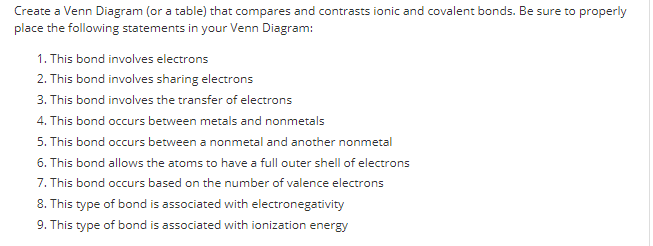Create a Venn Diagram (or a table) that compares and contrasts ionic and covalent bonds. Be sure to properly place the following statements in your Venn Diagram: 1. This bond involves electrons 2. This bond involves sharing electrons 3. This bond involves the transfer of electrons 4. This bond occurs between metals and nonmetals 5. This bond occurs between a nonmetal and another nonmetal 6. This bond allows the atoms to have a full outer shell of electrons 7. This bond occurs based on the number of valence electrons 8. This type of bond is associated with electronegativity 9. This type of bond is associated with ionization energy
Create a Venn Diagram (or a table) that compares and contrasts ionic and covalent bonds. Be sure to properly place the following statements in your Venn Diagram: 1. This bond involves electrons 2. This bond involves sharing electrons 3. This bond involves the transfer of electrons 4. This bond occurs between metals and nonmetals 5. This bond occurs between a nonmetal and another nonmetal 6. This bond allows the atoms to have a full outer shell of electrons 7. This bond occurs based on the number of valence electrons 8. This type of bond is associated with electronegativity 9. This type of bond is associated with ionization energy
ChapterU2: Smells: Molecular Structure And Properties
Section: Chapter Questions
Problem 3STP
Related questions
Question

Transcribed Image Text:Create a Venn Diagram (or a table) that compares and contrasts ionic and covalent bonds. Be sure to properly
place the following statements in your Venn Diagram:
1. This bond involves electrons
2. This bond involves sharing electrons
3. This bond involves the transfer of electrons
4. This bond occurs between metals and nonmetals
5. This bond occurs between a nonmetal and another nonmetal
6. This bond allows the atoms to have a full outer shell of electrons
7. This bond occurs based on the number of valence electrons
8. This type of bond is associated with electronegativity
9. This type of bond is associated with ionization energy
Expert Solution
This question has been solved!
Explore an expertly crafted, step-by-step solution for a thorough understanding of key concepts.
Step by step
Solved in 2 steps

Knowledge Booster
Learn more about
Need a deep-dive on the concept behind this application? Look no further. Learn more about this topic, chemistry and related others by exploring similar questions and additional content below.Recommended textbooks for you


Introductory Chemistry: A Foundation
Chemistry
ISBN:
9781285199030
Author:
Steven S. Zumdahl, Donald J. DeCoste
Publisher:
Cengage Learning

Introductory Chemistry: A Foundation
Chemistry
ISBN:
9781337399425
Author:
Steven S. Zumdahl, Donald J. DeCoste
Publisher:
Cengage Learning


Introductory Chemistry: A Foundation
Chemistry
ISBN:
9781285199030
Author:
Steven S. Zumdahl, Donald J. DeCoste
Publisher:
Cengage Learning

Introductory Chemistry: A Foundation
Chemistry
ISBN:
9781337399425
Author:
Steven S. Zumdahl, Donald J. DeCoste
Publisher:
Cengage Learning

Chemistry: The Molecular Science
Chemistry
ISBN:
9781285199047
Author:
John W. Moore, Conrad L. Stanitski
Publisher:
Cengage Learning

Chemistry for Today: General, Organic, and Bioche…
Chemistry
ISBN:
9781305960060
Author:
Spencer L. Seager, Michael R. Slabaugh, Maren S. Hansen
Publisher:
Cengage Learning
